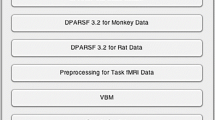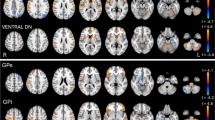Abstract
Increased brain iron content has been linked to neural degeneration and to age-related decline of cognitive and motor functions. The basal ganglia (BG), which contain significant amount of iron, play an important role in establishing and modulating force requirements in hand grasp to meet specific task demands. However, it is unclear if increased BG iron content contributes to age differences in hand grasp performance. To investigate the relationship between BG iron content and hand grasp force matching in older (65.0 ± 8.9 years) healthy women, participants generated a 20 % maximum voluntary exertion reference force that was matched with the opposite hand in the Contralateral Remembered (CR) and Contralateral Concurrent (CC) conditions and with the same hand in the Ipsilateral Remembered (IR) condition. T2* relaxation times calculated from MRI scans served to estimate iron content in the caudate nucleus (Cd), globus pallidus (GP), and putamen (Pt). Greater iron content in all BG was associated with relatively greater number of errors committed when matching force with the opposite hand in the CR and CC conditions than with the same hand in the IR condition. Younger women with greater estimated iron content committed more errors than their older counterparts with lesser estimated iron content in Cd and Pt. Greater iron content in the BG may contribute to sensorimotor declines in healthy women, and relative iron content quantified by MRI may be a promising biomarker of such.




Similar content being viewed by others
References
Adamo, D. E., Scotland, S., & Martin, B. J. (2012). Asymmetry in grasp force matching and sense of effort. Experimental Brain Research, 217(2), 273–285.
Akkal, D., Dum, R. P., & Strick, P. L. (2007). Supplementary motor area and presupplementary motor area: targets of basal ganglia and cerebellar output. The Journal of Neuroscience, 27(40), 10659–10673.
Alexander, G. E., DeLong, M. R., & Strick, P. L. (1986). Parallel organization of functionally segregated circuits linking basal ganglia and cortex. Annual Review of Neuroscience, 9, 357–381.
Anderson, C. M., Kaufman, M. J., Lowen, S. B., Rohan, M., Renshaw, P. F., & Teicher, M. H. (2005). Brain T2 relaxation times correlate with regional cerebral blood volume. Magnetic Resonance Materials in Physics, Biology and Medicine, 18(1), 3–6.
Bartzokis, G., Mintz, J., Sultzer, D., Marx, P., Herzberg, J. S., Phelan, C. K., et al. (1994). In vivo MR evaluation of age-related increases in brain iron. American Journal of Neuroradiology, 15(6), 1129–1138.
Bartzokis, G., Tishler, T. A., Lu, P. H., Villablanca, P., Altshuler, L. L., Carter, M., et al. (2007). Brain ferritin iron may influence age- and gender-related risks of neurodegeneration. Neurobiology of Aging, 28(3), 414–423.
Bartzokis, G., Lu, P. H., Tingus, K., Peters, D. G., Amar, C. P., Tishler, T. A., et al. (2011). Gender and iron genes may modify associations between brain iron and memory in healthy aging. Neuropsychopharmacology, 36(7), 1375–1384.
Benjamini, Y., & Hochberg, Y. (1995). Controlling the false discovery rate: a practical and powerful approach to multiple testing. Journal of the Royal Statistical Society: Series B: Methodological, 57, 289–300.
Bilgic, B., Pfefferbuam, A., Rohlfing, T., Sullivan, E., & Adalsteinsson, E. (2011). MRI estimates of brain iron concentration in normal aging using quantitative susceptibility mapping. NeuroImage, 59(3), 2625–2635.
Boecker, H., Lee, A., Muhlau, M., Ceballos-Baumann, A., Ritzl, A., Spilker, M. E., et al. (2005). Force level independent representations of predictive grip force-load force coupling: a PET activation study. NeuroImage, 25(1), 243–252.
Burnett, R. A., Laidlaw, D. H., & Enoka, R. M. (2000). Coactivation of the antagonist muscle does not covary with steadiness in old adults. Journal of Applied Physiology, 89(1), 61–71.
Dafotakis, M., Sparing, R., Eickhoff, S. B., Fink, G. R., & Nowak, D. A. (2008). On the role of the ventral premotor cortex and anterior intraparietal area for predictive and reactive scaling of grip force. Brain Research, 1228, 73–80.
Daugherty, A., & Raz, N. (2012). Age-related differences in iron content of subcortical nuclei observed in vivo: A Meta-Analysis. NeuroImage. doi:10.1016/j.neuroimage.2012.12.040.
DeLong, M. R., & Georgopoulous, A. P. (1981). Motor functions of the basal ganglia. In: Handbook of Physiology, The Nervous System. V.B. Brooks, volume editor, J.M. Brookhart and V.B. Mountcastle, section editors. Section 1, Volume II, Part 2. American Physiological Society, Bethesda, Maryland, pp. 1071–1061.
Ding, B., Chen, K. M., Ling, H. W., Sun, F., Li, X., Wan, T., et al. (2009). Correlation of iron in the hippocampus with MMSE in patients with Alzheimer’s disease. Journal of Magnetic Resonance Imaging, 29(4), 793–798.
Dum, R. P., & Strick, P. L. (2003). An unfolded map of the cerebellar dentate nucleus and its projections to the cerebral cortex. Journal of Neurophysiology, 89(1), 634–639.
Duyn, J. H., van Gelderen, P., Li, T. Q., de Zwart, J. A., Koretsky, A. P., & Fukunaga, M. (2007). High-field MRI of brain cortical substructure based on signal phase. Proceedings of the National Academy of Sciences of the United States of America, 104(28), 11796–11801.
Dziewulska, D., Domitrz, I., & Domzal-Stryga, A. (2010). Dementia means number of things - the overlap of neurodegeneration with brain iron accumulation (NBIA) and Alzheimer changes: an autopsy case. Folia Neuropathologica, 48(2), 129–133.
Fling, B. W., & Seidler, R. D. (2012). Fundamental differences in callosal structure, neurophysiologic function, and bimanual control in young and older adults. Cerebral Cortex, 22(11), 2643–2652.
Fukunaga, M., Li, T. Q., van Gelderen, P., de Zwart, J. A., Shmueli, K., Yao, B., Lee, J., Maric, D., Aronova, M. A., Zhang, G., Leapman, R. D., Schenck, J. F., Merkle, H., & Duyn, J. H. (2010). Layer-specific variation of iron content in cerebral cortex as a source of MRI contrast. Proceedings of the National Academy of Sciences of the United States of America, 107, 3834–3839.
Galganski, M. E., Fuglevand, A. J., & Enoka, R. M. (1993). Reduced control of motor output in a human hand muscle of elderly subjects during submaximal contractions. Journal of Neurophysiology, 69(6), 2108–2115.
Gooijers, J., Caeyenberghs, K., Sisti, H. M., Geurts, M., Heitger, M. H., Leemans, A., et al. (2013). Diffusion tensor imaging metrics of the corpus callosum in relation to bimanual coordination: Effect of task complexity and sensory feedback. Human Brain Mapping, 34(1), 241–252.
Gorell, J. M., Ordidge, R. J., Brown, G. G., Deniau, J. C., Buderer, N. M., & Helpern, J. A. (1995). Increased iron-related MRI contrast in the substantia nigra in Parkinson’s disease. Neurology, 45(6), 1138–1143.
Greenberg, S. M., Vernooij, M. W., Cordonnier, C., Viswanathan, A., Al-Shahi Salman, R., Warach, S., et al. (2009). Cerebral microbleeds: a guide to detection and interpretation. Lancet Neurology, 8(2), 165–174.
Haacke, E. M., Cheng, N. Y., House, M. J., Liu, Q., Neelavalli, J., Ogg, R. J., et al. (2005). Imaging iron stores in the brain using magnetic resonance imaging. Journal of Magnetic Resonance Imaging, 23(1), 1–25.
Haacke, E. M., Miao, Y., Liu, M., Habib, C. A., Katkuri, Y., Liu, T., et al. (2010). Correlation of putative iron content as represented by changes in R2* and phase with age in deep gray matter of healthy adults. Journal of Magnetic Resonance Imaging, 32(3), 561–576.
Hallgren, B., & Sourander, P. (1958). The effect of age on the non-haemin iron in the human brain. Journal of Neurochemistry, 3(1), 41–51.
Holsapple, J. W., Preston, J. B., & Strick, P. L. (1991). The origin of thalamic inputs to the “hand” representation in the primary motor cortex. Journal of Neuroscience, 11(9), 2644–2654.
Johansen-Berg, H., Della-Maggiore, V., Behrens, T. E., Smith, S. M., & Paus, T. (2007). Integrity of white matter in the corpus callosum correlates with bimanual co-ordination skills. NeuroImage, 36(2), 16–21.
Keen, D. A., Yue, G. H., & Enoka, R. M. (1994). Training-related enhancement in the control of motor output in elderly humans. Journal of Applied Physiology, 77(6), 2648–2658.
Langkammer, C., Krebs, N., Goessler, W., Scheurer, E., Yen, K., Fazekas, F., & Ropele, S. (2012). Susceptibility induced gray-white matter MRI contrast in the human brain. NeuroImage, 59, 1413–1419.
Lodygensky, G. A., Marques, J. P., Maddage, R., Perroud, E., Sizonenko, S. V., Hüppi, P. S., & Gruetter, R. (2012). In vivo assessment of myelination by phase imaging at high magnetic field. NeuroImage, 59, 1979–1987.
Middleton, F. A., & Strick, P. L. (2000). Basal ganglia and cerebellar loops: motor and cognitive circuits. Brain Research Reviews, 31(2–3), 236–250.
Middleton, F. A., & Strick, P. L. (2002). Basal-ganglia ‘projections’ to the prefrontal cortex of the primate. Cerebral Cortex, 12(9), 926–935.
Mushiake, H., & Strick, P. L. (1995). Pallidal neuron activity during sequential arm movements. Journal of Neurophysiol, 74(6), 2754–2758.
Nambu, A., Yoshida, S., & Jinnai, K. (1988). Projection on the motor cortex of thalamic neurons with pallidal input in the monkey. Experimental Brain Research, 71(3), 658–662.
Noble, J. W., Eng, J. J., Kokotilo, K. J., & Boyd, L. A. (2011). Aging effects on the control of grip force magnitude: an fMRI study. Experimental Gerontology, 46(6), 453–461.
Ogg, R. J., Langston, J. W., Haacke, E. M., Steen, R. G., & Taylor, J. S. (1999). The correlation between phase shifts in gradient-echo MR images and regional brain iron concentration. Magnetic Resonance Imaging, 17(8), 1141–1148.
Oldfield, R. C. (1971). The assessment and analysis of handedness: the Edinburgh inventory. Neuropsychologia, 9(1), 97–113.
Pope, P., Wing, A. M., Praamstra, P., & Miall, R. C. (2005). Force related activations in rhythmic sequence production. NeuroImage, 27(4), 909–918.
Prodoehl, J., Yu, H., Wasson, P., Corcos, D. M., & Vaillancourt, D. E. (2008). Effects of visual and auditory feedback on sensorimotor circuits in the basal ganglia. Journal of Neurophysiology, 99(6), 3042–3051.
Prodoehl, J., Corcos, D. M., & Vaillancourt, D. E. (2009). Basal ganglia mechanisms underlying precision grip force control. Neuroscience and Biobehavioral Reviews, 33(6), 900–908.
Raz, N., & Kennedy, K. M. (2009). A Systems Approach to the Aging Brain: Neuroanatomic Changes, Their Modifiers, and Cognitive Correlates. In W. Jagust & M. D’Esposito (Eds.), Imaging the Aging Brain (pp. 43–70). New York, NY: Oxford University Press.
Rodrigue, K. M., Daugherty, A. M., Haacke, E. M., & Raz, N. (2012). The role of hippocampal iron concentration and hippocampal volume in age-related differences in memory. Cerebral Cortex. doi:10.1093/cercor/bhs139.
Shmueli, K., de Zwart, J. A., van Gelderen, P., Li, T. Q., Dodd, S. J., & Duyn, J. H. (2009). Magnetic susceptibility mapping of brain tissue in vivo using MRI phase data. Magnetic Resonance in Medicine, 62(6), 1510–1522.
Shrout, P. E., & Fleiss, J. L. (1979). Intraclass correlations: uses in assessing rater reliability. Psychological Bulletin, 86(2), 420–428.
Sofic, E., Riederer, P., Heinsen, H., Beckmann, H., Reynolds, G. P., Hebenstreit, G., & Youdim, M. B. (1988). Increased iron (III) and total iron content in post mortem substantia nigra of parkinsonian brain. Journal of Neural Transmission, 74(3), 199–205.
Spraker, M. B., Yu, H., Corcos, D. M., & Vaillancourt, D. E. (2007). Role of individual basal ganglia nuclei in force amplitude generation. Journal of Neurophysiology, 98(2), 821–834.
Sullivan, E. V., Adalsteinsson, E., Rohlfing, T., & Pfefferbaum, A. (2009). Relevance of iron deposition in deep gray matter brain structures to cognitive and motor performance in healthy elderly men and women: exploratory findings. Brain Imaging and Behavior, 3(2), 167–175.
Thomas, L. O., Boyko, O. B., Anthony, D. C., & Burger, P. C. (1993). MR detection of brain iron. American Journal of Neuroradiology, 14(5), 1043–1048.
Tishler, T. A., Raven, E. P., Lu, O. H., Altshuler, L. L., & Bartzokis, G. (2012). Premenopausal hysterectomy is associated with increased brain ferritin iron. Neurobiology of Aging, 33, 1950–1958.
Turner, R. S., Desmurget, M., Grethe, J., Crutcher, M. D., & Grafton, S. T. (2003). Motor subcircuits mediating the control of movement extent and speed. Journal of Neurophysiology, 90(6), 3958–3966.
Vaillancourt, D. E., Mayka, M. A., Thulborn, K. R., & Corcos, D. M. (2004). Subthalamic nucleus and internal globus pallidus scale with the rate of change of force production in humans. NeuroImage, 23(1), 175–186.
Vaillancourt, D. E., Yu, H., Mayka, M. A., & Corcos, D. M. (2007). Role of the basal ganglia and frontal cortex in selecting and producing internally guided force pulses. NeuroImage, 36(3), 793–803.
Voelcker-Rehage, C., & Alberts, J. L. (2005). Age-related changes in grasping force modulation. Experimental Brain Research, 166(1), 61–70.
Ward, N. S., Swayne, O. B., & Newton, J. M. (2008). Age-dependent changes in the neural correlates of force modulation: an fMRI study. Neurobiology of Aging, 29(9), 1434–1446.
Wasson, P., Prodoehl, J., Coombes, S. A., Corcos, D. M., & Vaillancourt, D. E. (2010). Predicting grip force amplitude involves circuits in the anterior basal ganglia. NeuroImage, 49(4), 3230–3238.
Youdim, M. B. (1988). Iron in the brain: implications for Parkinson’s and Alzheimer’s diseases. The Mount Sinai Journal of Medicine, 55(1), 97–101.
Zecca, L., Youdim, M. B., Riederer, P., Connor, J. R., & Crichton, R. R. (2004). Iron, brain ageing and neurodegenerative disorders. Nature Reviews Neuroscience, 5(11), 863–873.
Zhang, S., Wang, J., Song, N., Xie, J., & Jiang, H. (2009). Up-regulation of divalent metal transporter 1 is involved in 1-methyl-4-phenylpyridinium (MPP(+))-induced apoptosis in MES23.5 cells. Neurobiology of Aging, 30(9), 1466–1476.
Acknowledgments
NR was supported in part by the NIH grant R37 AG011230
DA was supported in part by the Wayne State University Junior Faculty Grant
Author information
Authors and Affiliations
Corresponding author
Rights and permissions
About this article
Cite this article
Adamo, D.E., Daugherty, A.M. & Raz, N. Grasp force matching and brain iron content estimated in vivo in older women. Brain Imaging and Behavior 8, 579–587 (2014). https://doi.org/10.1007/s11682-013-9284-6
Published:
Issue Date:
DOI: https://doi.org/10.1007/s11682-013-9284-6




